
views
Preventing Your Cockatiel From Laying Eggs
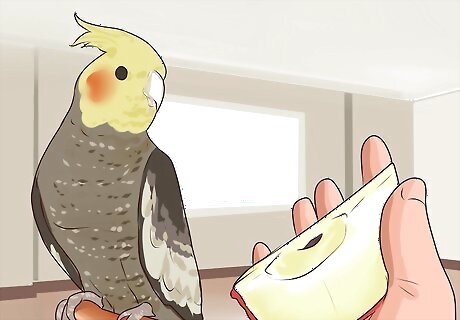
Change your cockatiel’s diet. In the wild, cockatiels will be ready to mate when they have access to sources of fat and protein in their environment. If your cockatiel’s diet is rich in fat and protein, her body will essentially be in a constant state of being ready to mate and lay eggs. You should not go as far as removing all of the fat and protein out of her diet, but you can start giving her more low-fat foods, such as fruits and vegetables. Decrease her intake of birdseed, since this is typically high in fat. Consult with your avian veterinarian for guidance on making her diet more healthy without cutting out any important nutrients.

Remove potential nesting sites. The more places that your cockatiel can find to nest, the more likely she will lay eggs. Potential nesting sites include just about any areas that are dark and quiet on the inside where she can hide, such as empty cardboard boxes, small bird tents, and old clothes. If you occasionally let your cockatiel out of her cage, she may also try to seek out other locations for nesting, such as closets and empty cabinets. Keeping her in her cage more often will reduce the chances of her finding places in your house to nest.
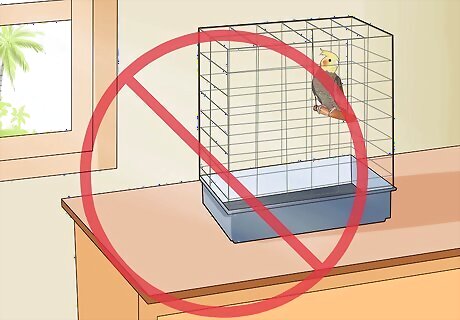
Decrease your cockatiel’s exposure to direct sunlight. For wild and captive cockatiels, the urge to mate will begin when there is more than 12 hours of daylight (spring and summertime). Your cockatiel may be laying eggs because her cage is receiving 12 or more hours of direct sunlight. Try moving her cage to an area of your house where it will not be in the direct path of sunlight for more than half of the day. Another option is to partially cover her cage with a towel or piece of bed linen during the day to keep out the direct sunlight.
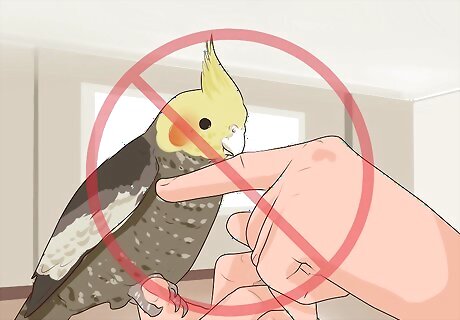
Prevent inappropriate pair bonding. If you spend a lot of time bonding with your cockatiel, you may not realize that she might see you as a mate. Doing things such as petting her head or scratching under her wings mimics what cockatiels do in the wild with their mate, as either a mating ritual or regular preening. Although you want to have a good relationship with your cockatiel, you certainly do not want her to mistake you as an object of her affection! Talking to your cockatiel and having her in the room with you are ways in which you can bond without her seeing you as her mate. Cockatiels are very vocal and enjoy talking, so she may even start talking back to you. Your cockatiel may also see an inanimate object, such as a stuffed animal or mirror, as a potential mate. Remove these items from her cage.

Induce molting. Molting occurs when a bird sheds her old feathers and grows new ones. A female bird will typically molt after she has finished laying her eggs and weaned her babies. For your cockatiel, inducing her to molt after she has laid her eggs will send a signal to her body that she should not try to lay any more eggs. You can induce molting by making changes to her environment, such as moving her cage to a different location or rearranging some of the items in her cage.
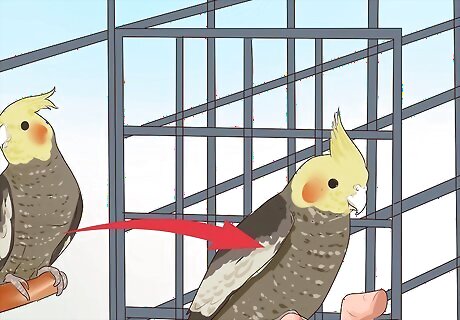
Separate your cockatiel from the other bird. This will be important if you have more than one cockatiel. If you have two females and one is a chronic egg layer, she may stimulate your other female to lay eggs as well. If you have a male and a female cockatiel, the male may want to mate with your female cockatiel. If either situation applies to you, it will be good to separate your cockatiels to reduce the likelihood of excessive egg laying. If you have a male and female cockatiel, trying to breed them to stop her from laying eggs is not recommended for several reasons. First, they simply might not be a good match for each other. Also, there is a risk of disease transmission if you do not know their disease statuses. In addition, your relationship with your female cockatiel may suffer, especially if you try to mate her and something goes wrong.
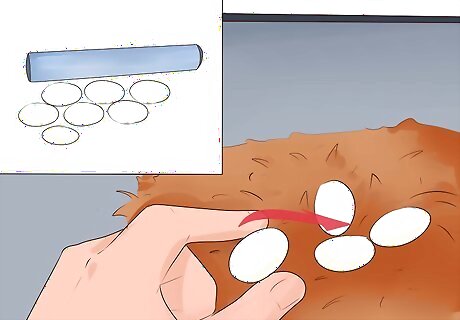
Place “mock” eggs in her nesting site. On average, a female cockatiel will lay about five to eight eggs at a time. She will be able to feel her eggs beneath her when she is laying on them, and will know when she has laid all of her eggs. To stimulate the feeling that she has finished laying all of her eggs, you can place marbles or scotch mints in her nesting site. Place the mock eggs in the nesting site when your cockatiel happens to stand up and move away from the nesting site. Mock eggs are also available at your local pet store.
Knowing What To Do When Your Cockatiel Lays Eggs
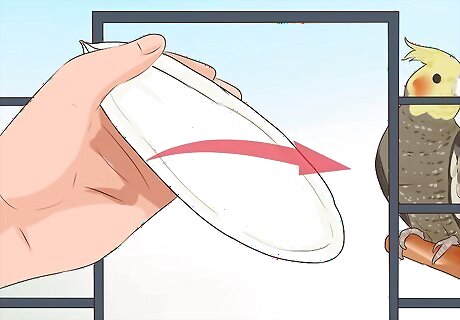
Improve her diet. Even though you want to stop your cockatiel’s egg laying, you will need to know what do if and when she starts laying eggs. Egg laying can be very taxing on your cockatiel’s body, so it will be important for her to be in the best nutritional state possible. One nutrient that she will need plenty of is calcium. Cuttlebone is an excellent source of calcium and can be found at your local pet store. She may also need a multivitamin to add more vitamins and minerals to her diet, especially if she primarily eats birdseed. If your cockatiel is on a pelleted diet, she may not need additional calcium supplementation. Over-supplementation is not good for your cockatiel. Consult with your avian veterinarian to determine what supplements your cockatiel may need to keep her healthy for laying eggs. Make sure that she also has access to plenty of fresh water.

Do not remove the eggs right away. Because your cockatiel will be able to sense when she has finished laying her clutch of eggs, removing the eggs from the nesting site too soon will essentially take that sense away from her. She will continue to lay eggs until she feels like she has laid enough, which could lead to a serious calcium deficiency and other medical problems. It is recommended to wait for anywhere from eleven days to three weeks after she has finished laying her eggs to remove them from the nesting site. A female cockatiel, whether wild or captive, will typically abandon her eggs three weeks after she has finished laying them. Remove the eggs gradually–one at a time and every other day–until you have removed all of them. Removing them slowly will help her understand that the eggs are not fertile. Consult with your avian veterinarian on what to do with the eggs that you have removed.
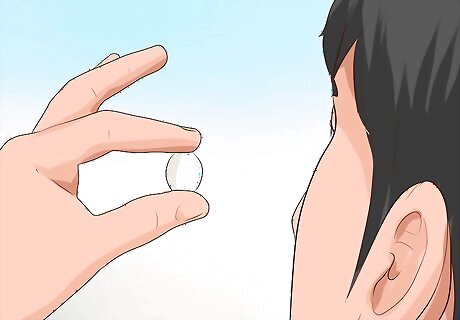
Examine the eggs. The look and feel of the eggs can serve as an indication of your cockatiel’s overall health. For example, if the shell looks misshapen or feels soft and thin, your cockatiel may be suffering from a nutritional deficiency. Abnormal-looking shells could also indicate an infection in your cockatiel’s reproductive tract. Because nutritional deficiencies and infections are serious medical conditions that require immediate treatment, take your cockatiel to your avian veterinarian if your bird’s eggs are in bad shape. Eggs that are broken or cracked should be removed immediately, since they are more susceptible to bacterial growth. Replace these eggs with mock eggs so that your cockatiel does not sense that she has not laid enough eggs.
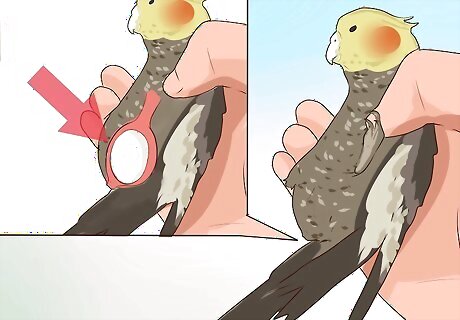
Monitor your cockatiel for illness. There are a number of medical conditions that can result from excessive egg laying, all of which require veterinary treatment. One condition is egg binding, in which the egg becomes stuck in your cockatiel’s reproductive tract and cannot be expelled from her body. If your cockatiel is showing signs of distress or struggle with laying her eggs, take her to your avian veterinarian for immediate treatment. Other signs of egg binding are difficulty breathing and blood coming from your cockatiel’s vent (where the egg passes through). Excessive egg laying can also lead to your cockatiel’s reproductive tract being pushed through her vent. This would also require immediate veterinary treatment. Your cockatiel could also develop hyperlipidemia, which means that too much fat is in her blood. This is caused by extra fat and protein being in her blood during egg development. Her blood could thicken if there is too much circulating fat, which could lead to a stroke. Your cockatiel may also have broken bones as a result of excessive egg laying, due to the loss of calcium.










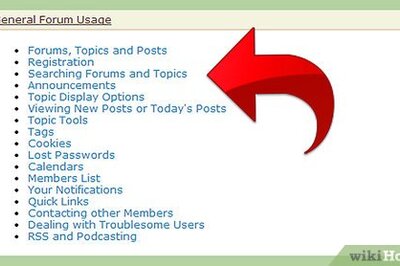


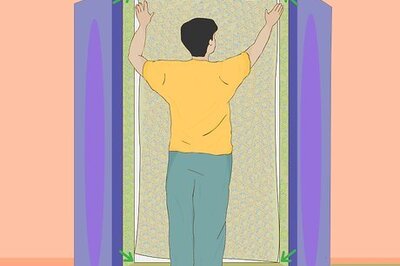
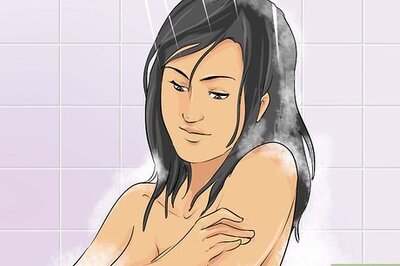




Comments
0 comment